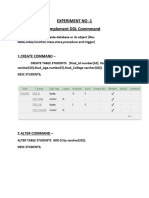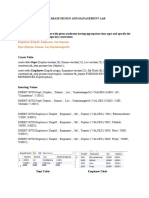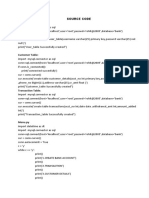SQL
Uploaded by
pannalalchaudhary283SQL
Uploaded by
pannalalchaudhary2831. If a table which has one Primary key and two alternate keys.
How many
Candidate keys will this table have?
(A) 1
(B) 2
(C) 3
(D) 4
(C) 3
2 Which SQL command can change the degree of an existing relation?
Alter (or Alter Table)
3 In which datatype the value stored is padded with spaces to fit the specified length. (A) DATE
(B) VARCHAR (C) FLOAT (D) CHAR
(D) CHAR
4 Which aggregate function can be used to find the cardinality of a table? (A) sum() (B) count()
(C) avg() (D) max()
(B) count()
5 Assertion (A): A SELECT command in SQL can have both WHERE and HAVING clauses.
Reasoning (R): WHERE and HAVING clauses are used to check conditions, therefore, these
can be used interchangeably.
(C) A is True but R is False.
6 A) What constraint should be applied on a table column so that duplicate values are not
allowed in that column, but NULL is allowed.
OR
B) What constraint should be applied on a table column so that NULL is not allowed in that
column, but duplicate values are allowed.
(I) A) UNIQUE OR B) NOT NULL (1 mark for correct answer)
7. A) Write an SQL command to remove the Primary Key constraint from a table, named
MOBILE. M_ID is the primary key of the table.
OR
B) Write an SQL command to make the column M_ID the Primary Key of an already existing
table, named MOBILE.
A) ALTER TABLE MOBILE DROP PRIMARY KEY;
OR
B) ALTER TABLE MOBILE ADD PRIMARY KEY (M_ID);
8
IV) Display the sum of Price of all the orders for which the quantity is null.
(I) select Product, sum(Quantity) from orders group by product having sum(Quantity)>=5;
(II) select * from orders order by Price desc;
(III) select distinct C_Name from orders;
(IV) select sum(price) as total_price from orders where Quantity IS NULL;
9 Write the output
(I) Select c_name, sum(quantity) as total_quantity from orders group by c_name;
(II) Select * from orders where product like '%phone%';
(III) Select o_id, c_name, product, quantity, price from orders where price between
1500 and 12000;
(IV) Select max(price) from orders;
7
(I) Select * from FACULTY natural join COURSES where Salary<12000;
Or Select * from FACULTY, COURSES where Salary<12000 and facuty.f_id=courses.f_id;
(II) Select * from courses where fees between 20000 and 50000;
(III) Update courses set fees=fees+500 where CName like '%Computer%';
(IV) (A) Select FName, LName from faculty natural join courses where Came="System
Design";
Or Select FName, LName from faculty, courses where Came="System Design" and
facuty.f_id=courses.f_id;
OR (B) Select * from FACULTY, COURSES;
8
You might also like
- CH 6 - Introduction To DBMS and Its Concepts For Board Exam PDFNo ratings yetCH 6 - Introduction To DBMS and Its Concepts For Board Exam PDF6 pages
- RDBMS and HTML Mock Test - 1549084911357No ratings yetRDBMS and HTML Mock Test - 154908491135720 pages
- Question Bank-Mysql (Expected Board Questions)No ratings yetQuestion Bank-Mysql (Expected Board Questions)38 pages
- Lesson 10: Including Constraints: SQL Sample QuestionsNo ratings yetLesson 10: Including Constraints: SQL Sample Questions10 pages
- 12 Impq Informatics Practices CH 16 To 18No ratings yet12 Impq Informatics Practices CH 16 To 1844 pages
- Class XII-UNIT III - SQL and MySQL Notes_0 (1)No ratings yetClass XII-UNIT III - SQL and MySQL Notes_0 (1)6 pages
- Field Name Data Type (Size) Constraint Empid Integer (5) Primary Key Empname VARCHAR (20) Not Null Salary DECIMAL (8,2) DOJ DateNo ratings yetField Name Data Type (Size) Constraint Empid Integer (5) Primary Key Empname VARCHAR (20) Not Null Salary DECIMAL (8,2) DOJ Date2 pages
- Oracle Certleader 1z0-071 Practice Test 2021-Jun-15 by Dick 237q VceNo ratings yetOracle Certleader 1z0-071 Practice Test 2021-Jun-15 by Dick 237q Vce26 pages
- Qno. 5 SQL 2014 Q.Paper: (B) Write The SQL Queries (1 To 4)No ratings yetQno. 5 SQL 2014 Q.Paper: (B) Write The SQL Queries (1 To 4)37 pages
- Important SQL Practice Questions With AnswersNo ratings yetImportant SQL Practice Questions With Answers7 pages
- Cassandra Query Language by Examples - Puzzles with AnswersFrom EverandCassandra Query Language by Examples - Puzzles with AnswersNo ratings yet
- Experiment No - 1 Implement DDL Commmand DDL:-: 1.create CommandNo ratings yetExperiment No - 1 Implement DDL Commmand DDL:-: 1.create Command15 pages
- Introduction To Azure SQL Databases FamilyNo ratings yetIntroduction To Azure SQL Databases Family6 pages
- Chapter 13: Filter Results Using WHERE and HavingNo ratings yetChapter 13: Filter Results Using WHERE and Having49 pages
- SQL Cookbook 1st Edition Anthony Molinaro downloadNo ratings yetSQL Cookbook 1st Edition Anthony Molinaro download52 pages
- Normalization Step by Step (Lecturer Version)No ratings yetNormalization Step by Step (Lecturer Version)6 pages
- Alfresco With OpenLDAP (Simple Authentication, v3.1.1)No ratings yetAlfresco With OpenLDAP (Simple Authentication, v3.1.1)10 pages
- PostgreSQL 8 For Windows (Blum 2007-04-12) (9F4B1AA7)No ratings yetPostgreSQL 8 For Windows (Blum 2007-04-12) (9F4B1AA7)402 pages






























































































